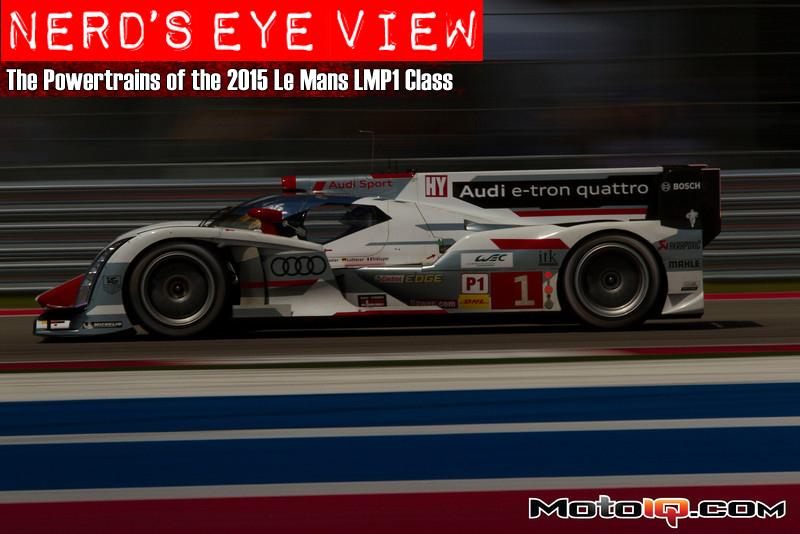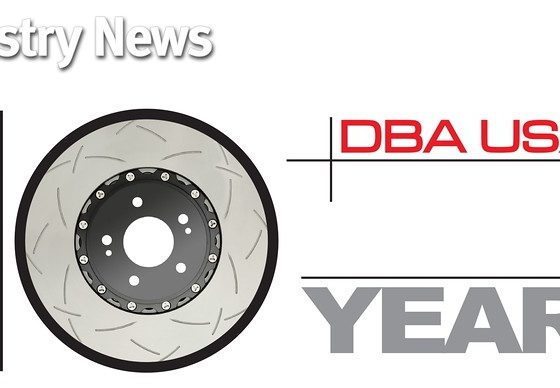,
 By placing the engine up front, Nissan is able to start the coke bottle narrowing shape of the body work further up front in the chassis which is akin to a narrower angle diffuser; therefore, there should be less aero drag. All the other cars have an engine in the middle along with heat exchangers and other bits which the bodywork has to work around. This Nissan does not and therefore does not have to compromise on the aero in the middle and rear of the car. If you follow F1, you know all those teams do everything they can to make the rear bodywork of the car as narrow as possible for the best rear aero possible. This car was originally going to be AWD with the hybrid system powering the rear wheels. However, that system required a very complex drivetrain to avoid having axles poking into the airstream at the rear of the car. The extreme measures the team went through just to avoid having rear axles in the airstream lends to the importance of the aero at the rear of the car. With some 1250hp being sent through the front tires alone, they are quite wide at 14”. The rear tires are narrower at 9” wide which should also reduce aero drag. As development time is short, Nissan opted to only go FWD for Le Mans so as to maximize reliability. The compromise of the front-engine and FWD configuration will likely be tire wear in my opinion. (Photo from Nissan)
By placing the engine up front, Nissan is able to start the coke bottle narrowing shape of the body work further up front in the chassis which is akin to a narrower angle diffuser; therefore, there should be less aero drag. All the other cars have an engine in the middle along with heat exchangers and other bits which the bodywork has to work around. This Nissan does not and therefore does not have to compromise on the aero in the middle and rear of the car. If you follow F1, you know all those teams do everything they can to make the rear bodywork of the car as narrow as possible for the best rear aero possible. This car was originally going to be AWD with the hybrid system powering the rear wheels. However, that system required a very complex drivetrain to avoid having axles poking into the airstream at the rear of the car. The extreme measures the team went through just to avoid having rear axles in the airstream lends to the importance of the aero at the rear of the car. With some 1250hp being sent through the front tires alone, they are quite wide at 14”. The rear tires are narrower at 9” wide which should also reduce aero drag. As development time is short, Nissan opted to only go FWD for Le Mans so as to maximize reliability. The compromise of the front-engine and FWD configuration will likely be tire wear in my opinion. (Photo from Nissan) A gasoline twin-turbo 3.0L V6 sits up front with the hybrid flywheel energy storage system sandwiched between the engine and driver. You can see all the heat exchangers stacked at the front with the air ducted out the top of the hood (better not crunch the front-end in a crash…). This keeps all the air flow going under and through the car clean. The exhausts from the turbos are also shot out the top of the car as keeping the airflow under and through the car to a minimum is critical to aero performance. (Photo from Road & Track, Marshall Pruett)
A gasoline twin-turbo 3.0L V6 sits up front with the hybrid flywheel energy storage system sandwiched between the engine and driver. You can see all the heat exchangers stacked at the front with the air ducted out the top of the hood (better not crunch the front-end in a crash…). This keeps all the air flow going under and through the car clean. The exhausts from the turbos are also shot out the top of the car as keeping the airflow under and through the car to a minimum is critical to aero performance. (Photo from Road & Track, Marshall Pruett) Here’s the money shot showing the straight airflow path through the massive tunnels from the front of the car all the way through to the rear. This airflow path should really minimize the size of the rear wake of the car minimizing aero drag. I’m guessing it’ll also help with the interaction of the airflow under the car and through the diffuser making for low-drag high-downforce generation. You can also see how the driver compartment has a nice teardrop shape which is about is ideal as you can get to minimize drag. Minimizing drag is everything at Le Mans with the massively long Mulsanne Straight; that’s why Toyota had the cheater moveable aero rear wing last year to reduce drag taking a play out of the old F1 cheat book. (Photo from Road & Track, Marshall Pruett)
Here’s the money shot showing the straight airflow path through the massive tunnels from the front of the car all the way through to the rear. This airflow path should really minimize the size of the rear wake of the car minimizing aero drag. I’m guessing it’ll also help with the interaction of the airflow under the car and through the diffuser making for low-drag high-downforce generation. You can also see how the driver compartment has a nice teardrop shape which is about is ideal as you can get to minimize drag. Minimizing drag is everything at Le Mans with the massively long Mulsanne Straight; that’s why Toyota had the cheater moveable aero rear wing last year to reduce drag taking a play out of the old F1 cheat book. (Photo from Road & Track, Marshall Pruett)The four engine configurations between the four competitors are V4, V6, and V8. Gasoline and diesel fuel are used. Three of the engines have turbos. Of those turbos, one set seems conventional, one is a VNT, and the secretive one uses some new low inertia turbine and compressor geometries. For energy storage, two cars use flywheels, one a battery, and the remaining capacitors. Three of the cars use one MGU-K, one uses two. One car uses a MGU-H to recovery even more energy otherwise lost. Three are mid-engine and AWD with the other being front engine and FWD.
How’s it all going to play out? Le Mans is a unique track and race where low drag and reliability are the keys to success. Audi is the benchmark having been the dominant force. Toyota was the first major challenger to try something different by going with a naturally aspirated V8 as opposed to the turbo diesel in the Audi. My thought (and feel free to disagree with anything I think) are that Toyota is compromised on aero due to the longer length V8 and larger volume capacitors. I feel they compromised on aero to use more conventional technologies for better reliability. Last year, they had the cheater wing to lower drag, but this year in the first practice with no cheater wing, they are down on lap time compared to the quickest Porsche followed by Audi. Porsche, with a year under its belt, may have the best aero package of the mid-engine cars with the super compact V4. Last year, they suffered with the reliability of their drastically different V4 engine but perhaps they’ll have the reliability to win this year. So far, they have the fastest practice times.
The unknown is Nissan. I’ve said this to a few people, but it’ll be extremely difficult to beat Audi while using their same basic formula. Peugeot tried and it took them a few tries to beat Audi. Toyota has been trying but I think their setup is too conventional. Porsche has gone somewhat radical, but again its small little changes compared to Audi. I think Nissan took the correct approach in analyzing the situation and determining that maximizing aero performance would be the only way to beat Audi at Le Mans leading to the front-engine concept enabling super low drag aero. With the lack of development time rendering the car only FWD, I feel the car is essentially a Le Mans special. However, with the massively long straights at Le Mans, I do not think being only FWD should be too great of a performance deficit. While Nissan is currently way behind on lap time after the first practice sessions (not to be unexpected on a brand new car in basically its first race), they do have the fastest trap speed… It appears that front-engine low-drag bodywork concept is working. Ninja edit: Personally, I think Nissan will use their low-drag aero to improve their fuel economy to eek out one extra lap per stint. If they can go one lap longer than everyone else, that could save them two pitstops over the course of the race. We’ll find out in a bit over a week!



